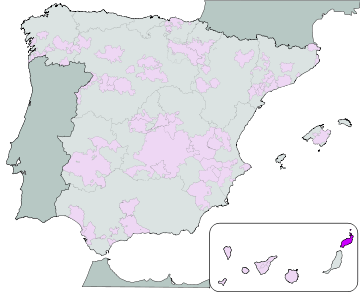Lanzarote (DO)

Lanzarote is a Spanish Denominación de Origen (DO) for wines that covers the entire island of Lanzarote, in the Canary Islands, Spain. It acquired its DO in 1993, and there are currently 2,300 ha under cultivation.
There are four subzones:
- La Geria, the largest and located in the south
- San Bartolomé/Tías (Masdache), in the centre
- Tinajo, in the centre-west
- Haría-Ye, in the north
Geography and Soils
Lanzarote, the easternmost island in the Canary islands has a unique and spectacular landscape in that the centre of the island is covered by solidified black lava (from a volcanic eruption in 1730-36). This means that nothing can grow there, but around the edges of this mass of lava, conditions are ideal for vines due to the presence of a layer of volcanic ash, known as lapilli or picón. This layer of ash allows quick absorption of rain, prevents it from evaporating, and helps to maintain constant the temperature of the soil underneath.
The vines are planted in holes or ditches so that their roots can reach the soil under the ash. Each hole or ditch is surrounded by a stone wall to protect the vine from the winds.
Over 75% of the vines planted are the Malvasia variety.
Climate
Lanzarote, being the island closest to Africa, is affected by the continent’s dry subtropical climate. Frost is unknown on the island. The sea breezes provide a temperate maritime climate. The mean temperatures range from 16°C to 34°C. Rainfall is very low (200 mm) and irregular throughout the year.
Grapes
The preferred authorized varieties are as follows:
- White: Burra blanca, Breval, Diego, Listán blanca, Malvasía, Moscatel and Pedro Ximénez
- Red: Listán negro (Negra común) and Negramoll (Mulata)
References
External links
- http://www.winesfromspain.com (English and Spanish)
- http://www. www.dolanzarote.com
Coordinates: 29°00′06″N 13°38′43″W / 29.00167°N 13.64528°W